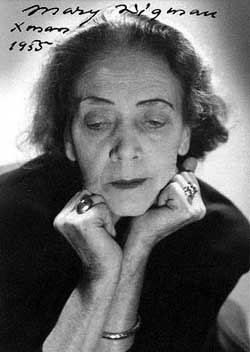Born into a well-to-do bourgeois family in Hannover in 1886, Karoline Sofie Marie Wiegemann attended the Ho¨here To¨chterschule (“higher school for daughters”) until the age of fourteen. It was during this time that she saw the Austrian Wiesenthal sisters perform their new interpretation of An der scho¨nen blauen Donau (The Blue Danube) in Hannover. She was fascinated by it, not only because it was a beautiful waltz, but also because of the sisters’ free and uninhibited interpretation of the traditional dance. Frustrated by not being able to attend university, Wigman, as she chose to call herself after her debut, decided to study dance.
In the artist colony of Hellerau, Wigman encountered a lifestyle that was completely different from her previous one. Hellerau was an experimental town whose citizens were intent on putting the ideals of social reform into practice. From the architecture of Heinrich Tessenow, based on his ideal of innovating the residential buildings of middle- and lower-class workers, to the “reform clothes” of women who no longer restricted their bodies, Hellerau stood at the forefront of the social, cultural and aesthetic innovations of the time. In the Biergarten and cafe´s, Wigman listened to lectures by Oskar Kokoshka, and heard the music of Igor Stravinsky, Alban Berg, Anton Weber and Arnold Scho¨nberg. She met other students of art, and artists who were part of the Bru¨cke or the Neue Sezession movement. She was truly in the heart of cultural and artistic experiments.
Wigman successfully completed the programme within two years and earned her certificate to become a teacher of Dalcroze’s method of rhythmic gymnastics, but she was becoming increasingly disillusioned with the limited nature of dance in the context of an institution where dance was considered to be a medium for music education. During this time, she showed one of her solo experiments to her good friends, the artist Emil Nolde and his wife, who suggested that she contact the choreographer Rudolf Laban, who was teaching a new type of dance in Ascona, Switzerland. Wigman decided to attend this counter-cultural community of artists, intellectuals and anarchists for the summer, little knowing that this would determine the future course of her life. Indeed, after only a year, Wigman was performing as a dancer with her solos Lento and Witch Dance I, her debut choreographies, which, significantly, were not accompanied by music and foregrounded dance itself as an autonomous art.
Ascona, or Monte Verita`, as it was called, was part of the larger Lebensreform movement, a cultural rebellion based on the ideal of rescuing the maimed human body from the stale environment of modern bourgeois society with its fixed norms and sterile values.9 Founded by Ida Hofmann and Henri Oedenkoven, near Lake Maggiore in Switzerland, Monte Verita` became a haven for artists, writers and intellectuals who wanted to pursue an alternative lifestyle, and it thus functioned simultaneously as an artists’ colony and a sanatorium. Among the figures who participated in one way or another were such writers as Hermann Hesse, Else Lasker-Schu¨ler and Marianne Werefkin; political anarchists and psychoanalysts such as Erich Mu¨hsam and Otto Gross, as well as the Dadaists Hugo Ball and Emmy Henning. Isadora Duncan was also an occasional guest. It was also here that Laban had been teaching dance since 1913 as part of its “Schule der Kunst” (“school of art”).
The Lebensreform movement quickly became popular among young people, who called out for changes in diet and health, and for the release of the body from socially constructed inhibitions. The human body became the only remaining authentic topos that seemed to hold the solution to the disintegrating individual identity and sense of community. In the colony, dance was adopted from the beginning as the ideal medium of communication for expressing the freedom of the body from oppressive social norms and codified behaviours. Free movement practices based on improvisation were part of the basic training with Laban, for whom regaining one’s uninhibited expressiveness meant finding “die neuen Formen eines einfachen und harmonischen Lebens” (“new forms of a simple and harmonious life”).10 The ideal of the Bewegungskunst (“art of movement”) that Laban taught in Monte Verita` was very closely related to the function of the colony as a sanatorium. “Movement” was supposed to become the solution for healing the minds and bodies of modern people.
(This journal article is from onesearch at IU http://eds.b.ebscohost.com.proxyiub.uits.iu.edu/eds/pdfviewer/pdfviewer?sid=cd5be34f-fa76-4f39-aa3c-f551e20afe52%40sessionmgr198&vid=2&hid=120)


It is clear to see how free movement practices have influenced Wigman's work because she was one of the firsts to use improvisational music in her pieces. It is interesting to see how she used what she learned from the free movement practices and applied it to aspects of her work that were not movement.
ReplyDeleteIn her early performances Wigman danced at times to no music at all or to the accompaniment of flutes or percussion instruments, such as African drums, Oriental gongs, or cymbals. Later she had music composed to accompany the movements of her individual dances—a new approach to dance accompaniment that proved to be widely influential.
ReplyDeletethis post introduce her dance style change for the early life. she was dance without music. but later after her find a new style she could dance with music perfectly. this is how new style dance be influence by the life
ReplyDeleteI want to visit those artist colonies!
ReplyDelete